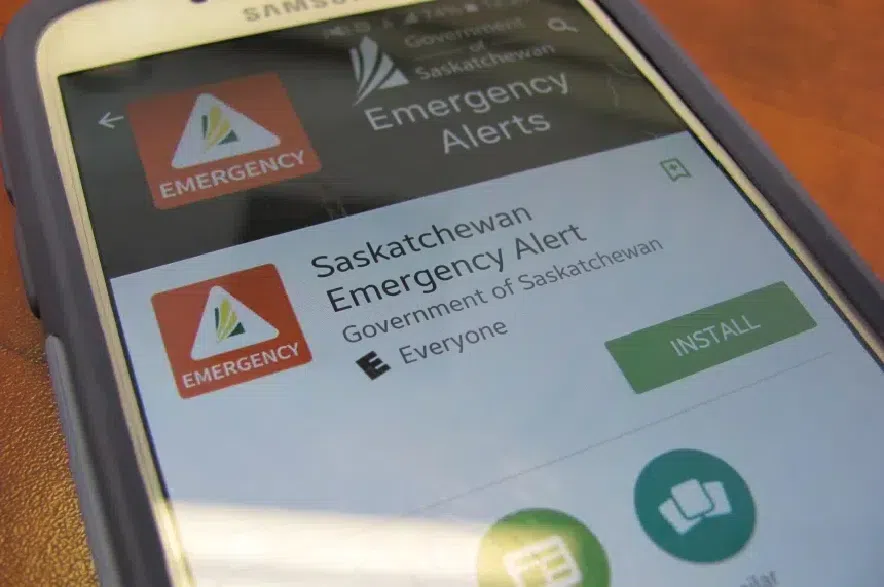By Teena Monteleone
As a lull sets in from the early and rampant fire season in Saskatchewan, questions are surfacing about the effectiveness and use of the province’s emergency alert system.
One of the issues came up early this spring, when staff at a rural municipality threatened by a wildfire tried to issue an evacuation alert but weren’t able to because nobody had the authority from the province to make such a request. Rather than deliver the news via cellphone, emergency personnel relied on a more time-consuming effort: knocking on each door in the community.
Read More:
- ‘Just unbelievable’: Emotional return for Denare Beach residents
- ‘Left to burn’: Saskatchewan family calls for answers after East Trout Lake wildfire
- Creighton residents return home, mayor says community undamaged by wildfires
Then, a different incident. A vague evacuation alert was issued due to a fire in Weyakwin, but the area outlined in the alert map contained the entire city of Prince Albert, setting off panic and confusion. The Saskatchewan Public Safety Agency (SPSA) sent out a correction and apology soon after.
Those two examples are not the the first time the province has had issues with SaskAlert. In 2023, an emergency alert concerning drinking water in Maple Creek was unintentionally sent to phones across the entire province. That issue was chalked up to user error, as town officials didn’t know certain options they selected on the notification would widen its distribution.
The SaskAlert app was launched in 2016. If someone wants to receive alerts, they have to register for the program and select the geographic area they want notifications for. The program is also connected to the National Public Alerting System (NPAS) – also known as Alert Ready. The national alerts are ‘broadcast intrusive’ meaning they will be broadcast on television and radio stations and sent to cellphones, whether you are registered for SaskAlert or not. Environment Canada, government ministries and Crowns, local governing jurisdictions like municipalities and First Nations, and police can all issue alerts.
The SPSA said all communities are aware of SaskAlert, and training requirements have been restructured to offer easier access to it. However, Saskatchewan currently has 766 urban, rural and northern municipalities, plus 70 First Nations, and there are only 235 jurisdictions currently registered for the emergency mass notification service.
“There are letters that have been sent out over the last number of years. We have worked with communities to make sure that they are aware of how they can either send out SaskAlerts on their own or, should they wish, we can send them out,” said SPSA president Marlo Pritchard. “There is a requirement to at least register as a community.”
Examples of the types of alerts issued over the last several years show very few actually issued by local governing jurisdictions.
A search of the SaskAlert archive between 2019 and 2025 shows hundreds of alerts issued, but the vast majority are related to weather events from Environment Canada, mostly for tornadoes. Fewer than 10 wildfire-related alerts were issued in 2021, which was the busiest wildfire season between 2019 and this year.
Deborah MacLeod lives in a rural area near White Fox that was threatened by recent wildfires. She expressed frustration with the SPSA about what she called a lack of firefighting response in her area, but also a lack of information.
“Even on their website, it’s not easy to find critical information. You have to click on about five tabs until you find the right thing,” MacLeod said. “But even with the alert, you know a lot of people in our area don’t have computer access, especially seniors, and even if it came to our phone we wouldn’t get SaskAlert because the cell service in this area is sporadic at best, so that’s why we still have a landline.”
MacLeod said she’s heard emergency alerts broadcast through her radio and television, but unless those devices are on 24/7, she said it would be hard to know an alert even been issued.
Others have complained the broadcast-intrusive alerts are hard to understand because the voice is automated and locations are often mispronounced.
Adding to the challenge in Saskatchewan is the fact some municipalities already use their own mass notification alert systems. North Battleford, Estevan and Warman, for example, use Voyent Alert, which residents must subscribe to. It is a community-level alerting system not directly connected to NPAS.
Kevin Skrepnek manages emergency response in British Columbia’s Thompson-Nicola Regional District, an area that has seen significant wildfire incidents in past years that have led to hundreds of evacuation alerts. Like Saskatchewan, B.C. has two methods for mass notifications. One is through the province, which is connected to NPAS. The other is through the services individual communities have subscribed to, like Voyent Alert.
“The disadvantage of this is that people must sign up, and because every local jurisdiction uses a different system, it can be inconsistently applied. Local governments and First Nations control these apps directly,” Skrepnek said.
And it’s not just local authorities that are struggling to navigate the public alerting landscape. In April 2020, Nova Scotia experienced Canada’s deadliest mass shooting, which claimed 23 lives. The RCMP, as the lead agency responding to the shooting, faced significant criticism for failing to issue an emergency alert to notify people of the presence of a mass shooter, partly because officers didn’t realize NPAS could be used for policing. A public inquiry examined the event, and the Mass Casualty Commission’s final report called for a national review of public alerting. The Canadian Association of Chiefs of Police said in a resolution it submitted that “significant governance gaps exist in many provinces and territories that must be addressed regarding civil emergency.”
“While specific ‘threat to life’ alert types have been identified by Alert Ready, the responsibilities, criteria and message content have not yet been clarified for these types of alerts,” the resolution read.
There have been some successes with the public alerting system. Following the Nova Scotia mass shooting, more emphasis was put on the tool, and during the mass stabbing incident on the James Smith Cree Nation in Saskatchewan in 2022, more than 10 emergency alerts were issued between September 4 and September 7, related to the manhunt for the suspect.
One of the recommendations from a coroner’s inquest on the mass stabbings, held last February, was to improve the country’s alert system. At the time, Rhonda Blackmore, then serving as the commanding officer of the Saskatchewan RCMP, said the alert system was not user friendly.
“It’s a system that sort of morphed into an emergency alerting system, and that has been problematic for us,” she said.
After the mass stabbing, the James Smith Cree Nation signed up for a subscription-based alerting app designed to allow First Nations leaders to issue emergency alerts about missing persons, public safety emergencies or natural disasters within their own communities. The app was specifically designed to be autonomous and separate from government emergency alert systems.
But despite the flaws, during the unprecedented early wildfire season in the province, many local jurisdictions were turning to SaskAlert. Several notifications were issued since May 28 to help alert and direct more than 10,000 evacuees, but concerns remain that risks will increase as local governments find alternate means of alerting community members.
The Canadian Association of Chiefs of Police said “the public will lose” if emergency communication systems don’t work together during local crises.











